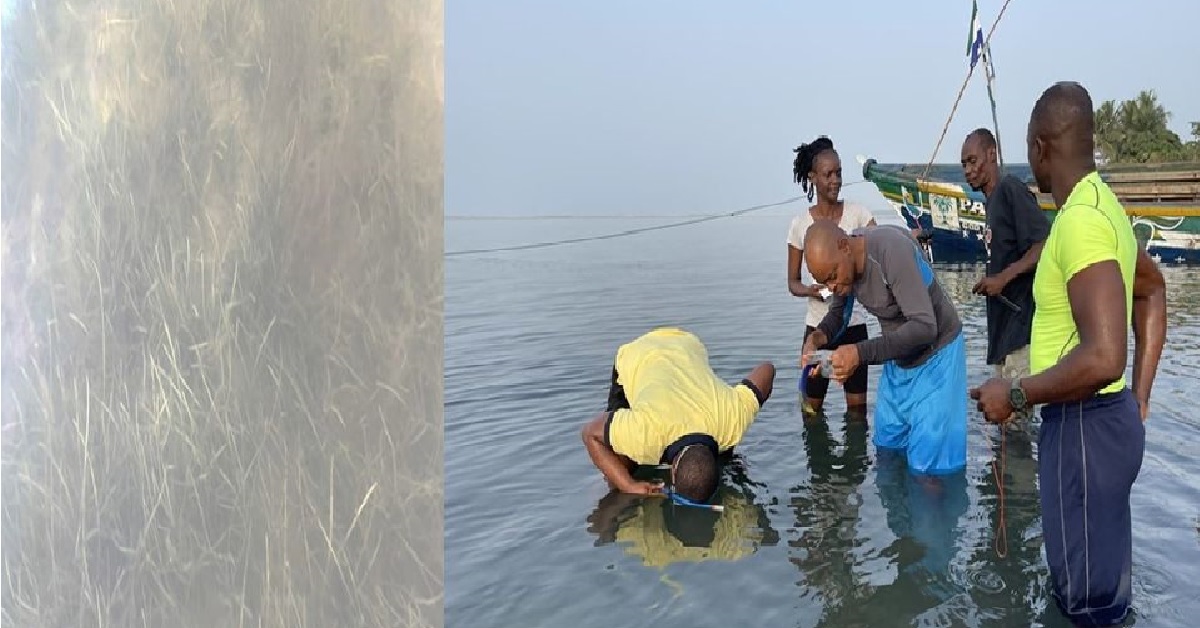The National Implementing Team (NIT) for the Seagrass project in Sierra Leone comprising representatives from the Environmental Protection Agency, the Institute of Marine Biology and Oceanography (IMBO), the Sierra Leone Navy as well as the Resilient SEA/GRID-Arendal Consultant, Professor Salomao Bandeira from Mozambique, have recently on the 25th March 2022 discovered a new location of seagrass in the Seh Community, part of the Turtle Islands in Southern Sierra Leone.
The new seagrass location in Sierra Leone is the third seagrass discovery in the country since 2019, after Bumpe toke and Mania islands. This is also an important discovery since the seven West African states (Sierra Leone, Guinea, Guinea Bissau, The Gambia, Senegal, Mauritania and Cape Verde) started documenting and monitoring seagrasses in the region with funding from the GRID-Arendal under the Resilien SEA project.
The Team took coordinates of the new site at Seh Island and proceeded with documentation of ecological monitoring parameters such as seagrass cover, shoot number, leaf height as well as seagrass area estimates. The average length of the new-found ranges from 9 – 11cm and covers a wide area of more than a quarter km. Similar process occurred at Bumpetoke, larger area, but with spacer continuous seagrass meadows. Seh has thriving seagrass meadows, is a picture model for seagrass training and community engagement for Sierra Leone but this place is highly threatened due to boat and trampling activities as well as plastic pollution.
“This is an impressive discovery which sends a clear message that with more effort and monitoring in new locations we will discover more seagrass in Sierra Leone,” said Paul A. Lamin, Project Coordinator and Deputy Director Natural Resources Management at the Environment Protection Agency of Sierra Leone.
“This new discovery by Sierra Leone will better place the country in the right position in the world map of seagrass” said Salomao Bandeira, from the GRID-Arendal.
Seagrasses are marine flowering plants found in shallow marine waters and in estuaries across the country. together with mangrove forests, which are abundant across the Sierra Leone estuaries, seagrass are key marine habitats that sustain fisheries and charismatic fauna, such as sea turtles, provide coastal protection, sequester carbon therefore reducing climate change, oxygenate the ocean making it clean without pathogens, and buffer ocean acidification.
In order to leave in marine environment, the seagrass themselves had to acquire adaptations such as (i) processing vertical stems with grass-like green leaves, interconnected with horizontal stems called rhizomes with roots providing necessary anchorage in the sea; (ii) adapt to uptake nutrients both from roots (common in all plants) but also fromleaves; (iii) having ahygrophilous pollination; (iv) possession of air-lacunnae in order to have the leaves to stand vertically in the water.
Within Sierra Leone, despite being only one seagrass species Halodulewrightii, there is habitat complexity enhancing the diversity and abundance of fauna observed within this expedition: fish, clams and other invertebrates. Sizable fish observed at the shallow water appeared significant in both Seh and Bumpetuk Islands. Expeditions members had the opportunity to learn about dangerous or need-care animals such as stingrays and sea snakes.
The Turtle Island lies in the south-eastern province of Sierra Leone. Its location is part of the Marine Protected Area (MPA) of Sherbro River estuary. The mission’s terms included discussion and assessment of ecosystem services as well as brainstorming on options to incorporate seagrass into national governance systems.
After the new seagrass meadow discovery, the team carried out informal community consultation about the value and importance of seagrass meadows, to the community themselves, as well as carried an open discussion on issues such on community engagement on seagrass conservation, building of a forum/network on seagrasses of both Seh and other sites within the Turtle Island archipelago. NIT, already a multi-actor forum will continue to monitor the progress of the seagrass comparing to its present status.
However, as the seagrass discoveries continue to unfold in Sierra Leone shiny waters, communities are on the high alert to put their wheels on motion to design protective measures that would see the protection of the marine grass.




 Post a comment
Post a comment









Comment(s)
Disclaimer: Comments expressed here do not reflect the opinions of Sierraloaded or any employee thereof.
Be the first to comment